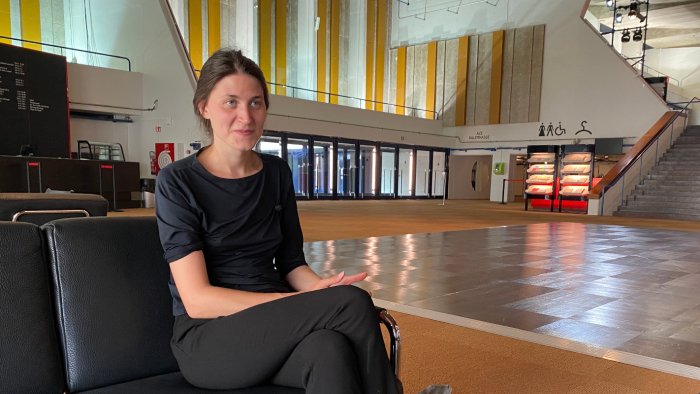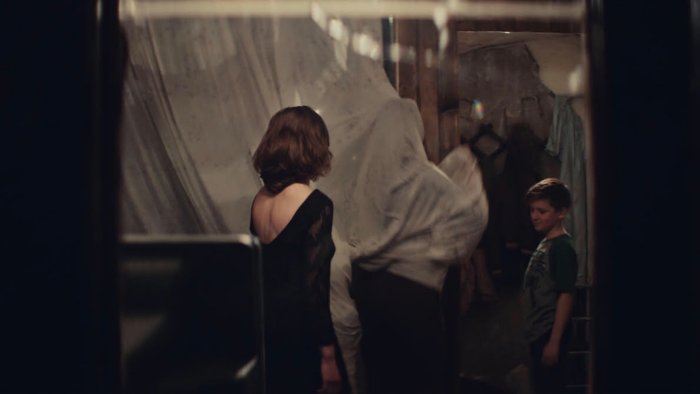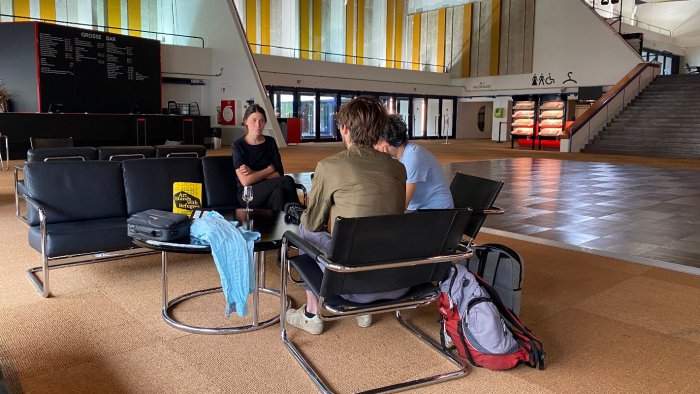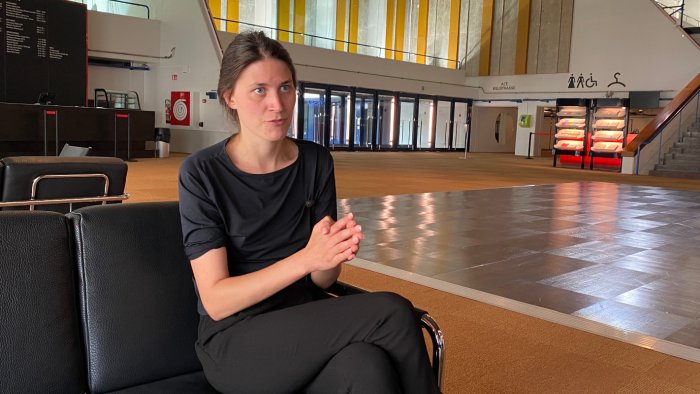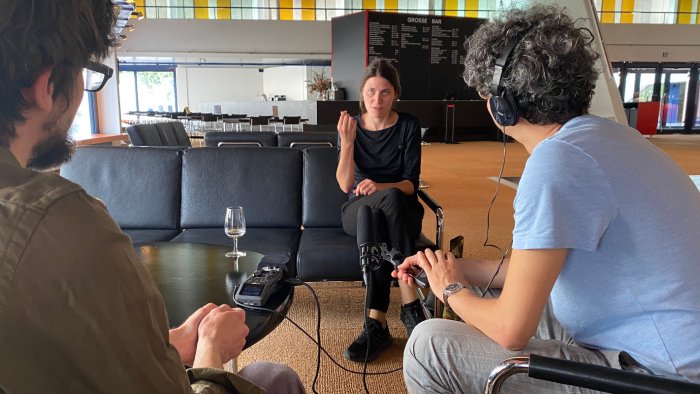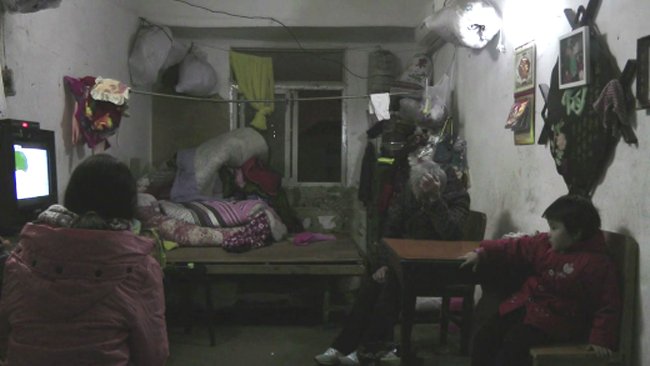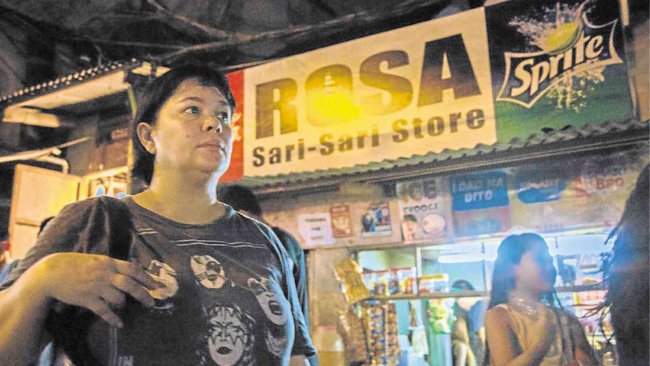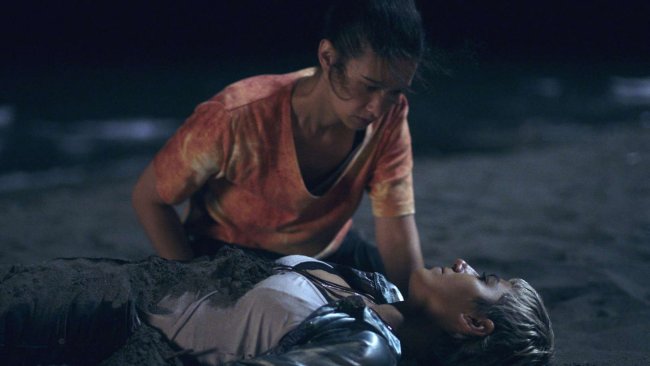Looking for Venera | Norika Sefa
[…] The framings strengthen this oppressive atmosphere, and it would be an understatement to say that the director and cinematographer Luis Armando Arteaga have made a great use of close shots. These express in a very subtle way the feeling of narrowness that characterises the mood or, as the Germans say, the Stimmung of the film.
[…] To put it short: the underground milieu Venera gets acquainted with is not less toxic than the patriarchal structures that prevail in town. Actually, this shady underworld does nothing but make more visible the gendered violence on which relies the social order.
Text: Emilien Gür | Audio/Video: Ruth Baettig
Podcast
Talk at the Bildrausch Filmfest Basel
Talk with Norika Sefa about «Looking for Venera» at Bildrausch Filmfest Basel.
Find a list of all our Podcasts here.
2021 has been so far a successful year for Kosovan cinema, with two feature films prized at major international festivals: Hive by Blerta Basholli, which received three awards at Sundance Film Festival, including the World Cinema Grand Jury Prize for fiction, and Looking for Venera [Në kërkim të Venerës] by Norika Sefa, winner of the Special Jury Award at Rotterdam. Since Samir Karahoda will be the first Kosovan director competing for a Palme d’or in Cannes this July with his short film Displaced [Pa vend], there are good reasons to believe that Kosovan cinema is gaining momentum. Let us hope that the success of these films will not only shed light on the talent of their directors (which they naturally deserve), but also raise attention on the critical lack of film funding in Europe’s newest country, as recently reported in BalkanInsight.
Looking for Venera is the first feature film by Norika Sefa, the youngest of the three directors mentioned. It is worth mentioning that prior to this, she directed a short film under the guidance of Werner Herzog, which was shot in the same location as Aguirre, The Wrath of God. All the more significant is that after this very global production experience (48 filmmakers from all over the world developing each a short film project in the Tambopata National Reserve), she decided to shoot her debut in a small town in Kosovo, which in comparison with the Peruvian jungle might appear quite narrow. It is the sort of place that epitomizes all too well the social structures of provincialism, where everyone keeps an eye of their neighbour. This state of things underpins a patriarchal order in which female sexualities, desires, and aspirations are tightly controlled. Teenager Venera is well aware of this: in order to find her way in life, she has to negotiate the gendered expectation her family puts on her in a rather implicit way (there is little talking between parents and children in the film, to say the least). Her schoolmate Dorina, whose rebellious attitude contrasts with the conservative climate of the town, is the only character to offer an alternative to the values of discretion and obedience Venera was raised with. The framings strengthen this oppressive atmosphere, and it would be an understatement to say that the director and cinematographer Luis Armando Arteaga have made a great use of close shots. These express in a very subtle way the feeling of narrowness that characterises the mood or, as the Germans say, the Stimmung of the film.
Looking for Venera opens with a rather ambiguous scene. Dorina and her boyfriend have sex on a sloping hill in the woods. I felt quite uncomfortable while watching it, for the clumsiness of the bodies and the violence of the gestures might suggest it is a rape. Venera witnesses the scene as well, and she neither knows how to interpret what she sees. Later at school, she confesses Dorina she has seen her in the woods. Both girls are not particularly close to each other, but these few words bound them together. Dorina quickly becomes a role model for Venera. She takes her to places where she had never been before, such as an abandoned factory turned into an illegal bar, and introduces her to alcohol and flirting. Almost every single scene is a first time for Venera: first cocktail, first kiss, first night out, etc. There is something truly violent about this process one might call a “coming of age”, not least because all interactions between male and female teenagers are permeated by some threatening bestiality. To put it short: the underground milieu Venera gets acquainted with is not less toxic than the patriarchal structures that prevail in town. Actually, this shady underworld does nothing but make more visible the gendered violence on which relies the social order: women are turned into sexual objects on the dance floor before getting locked up at home as housewives.
While Dorina internalizes the violence of her milieu, as made obvious by the scene where she tells her friend it is not a problem when a guy kisses her without asking her if she consents, Venera becomes little by little aware of the entanglement between the margin and the core of the society she lives in. Since the former does not offer her the opportunity to escape from the latter, she decides to disrupt the social order by pretending having an affair with a boy of her age. This compels her parents to consider giving her in marriage, as suggested by the last sequence of the film, where they meet the mother of the young man. At least, Venera picks the man she will be forced to marry. The film ends thus with a statement one might understand as fatalistic: one cannot escape from the violence of the social order; the only possibility left is to negotiate its rules. Yet such an interpretation would underestimate «the power of small gestures», to freely quote media scholar Markus Krajewski, namely disruptive acts subalterns might perform while conducting their daily tasks, which the following scene illustrates quite well. As Venera gets home late after her first night out, she starts dancing in the doorway. Her mother, who has been worrying for her, watches Venera without saying a word for a few minutes, before following her example. It is a very beautiful scene: two women of different generations dancing together, and thus transgressing their roles: the daughter does not go straight to bed, as it would be expected from her; the mother does not reprimand her for being late. A feeling of solidarity arises, as if it became clear to both characters that they belong to the same camp: that of the victims of patriarchy. Let their dance undo it.
This article contains a third-party video. If you would like to watch the video, please adjust your settings.
Watch
Screenings in May 2022 at Kino RiffRaff Zürich
Info
Looking for Venera – Në kërkim të Venerës | Film | Norika Sefa | RKS 2021 | 111’ | Peter Liechti Preis at Bildrausch Filmfest Basel
First published: July 05, 2021
